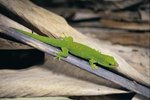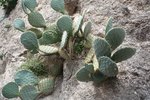
Feeding pet lizards can be tricky business; many species require hard-to-provide, animal-based foods such as live insects or frozen rodents. Avoid these problems entirely by selecting an herbivorous species such as a green iguana or prehensile-tailed skink as a pet. If you do not want a vegetarian lizard, choose an omnivorous species, which will limit the amount of animal-based food you have to provide.
Family of Foliovores
Hailing from the tropical forests throughout the New World, green iguanas (Iguana iguana) are arboreal foliovores -- leaf eaters -- that spend most of their time in the trees. Iguanas are very large, potentially aggressive lizards, requiring large and expensive caging, so they are best suited for experienced keepers. Most other iguanas, including spiny-tailed (Ctenosaura ssp.), Caribbean (Cyclura ssp.) and desert iguanas (Dipsosaurus dorsalis ssp.) are primarily or completely vegetarian as well, though some require insect prey as juveniles. No matter the species, feed your iguana leafy greens, green beans, squash, carrots, fruit and the occasional rose or hibiscus flower. Be sure to thoroughly wash all food items, and cut them into small pieces before offering them to your pet.
Berries in Your Beard
While bearded dragons (Pogona vitticeps) are omnivores that greedily consume insects, vegetables should form about 75 percent of an adult dragon’s diet. In the wild, bearded dragons inhabit very arid habitats; eating leaves, fruit and flowers enables them to obtain not only calories, but water as well. Make collard, mustard and turnip greens staples for your pet, but also provide a rotation of squash, green beans, carrots and berries.
Cactus-tailed Critters
Spiny-tailed lizards (Uromastyx ssp.) live in the hot and arid habitats of north Africa. Waking early in the morning to bask, spiny-tailed lizards begin foraging for edible plants, fruit and cactus flowers after attaining high body temperatures. If frightened, spiny-tailed lizards retreat to a rock crevice and cover the opening with their prickly tails. Young, growing spiny-tailed lizards require insects in their diet, but adults thrive when fed a primarily vegetarian diet, punctuated with insects once or twice weekly.
An Herbivore's Tail
Prehensile-tailed skinks (Corucia zebrata) are unusual representatives of the lizard clade. The largest skinks in the world, these 2- to 3-feet-long lizards are tree-dwelling, nocturnal foliovores. Prehensile-tailed skinks give live birth and the young stay with their mothers for extended periods. Prehensile-tailed skinks are active lizards that require large cages for their nighttime foraging. It is very important to start with a captive bred specimen that is accustomed to humans; when frightened these lizards can give a very painful bite.
References
- Animal Diversity Web: Iguana Iguana
- Arkive: Egyptian Spiny-Tailed Lizard (Uromastyx Aegyptia)
- Arkive: Guatemalan Spiny-Tailed Iguana (Ctenosaura Palearis)
- Sacramento Zoo: Prehensile-Tailed Skink
- Animal Diversity Web: Pogona Vitticeps
- Sea World: Cuban Iguana
- CaliforniaHerps.com: Dipsosaurus Dorsalis Dorsalis -- Northern Desert Iguana
Photo Credits
-
John Foxx/Stockbyte/Getty Images



